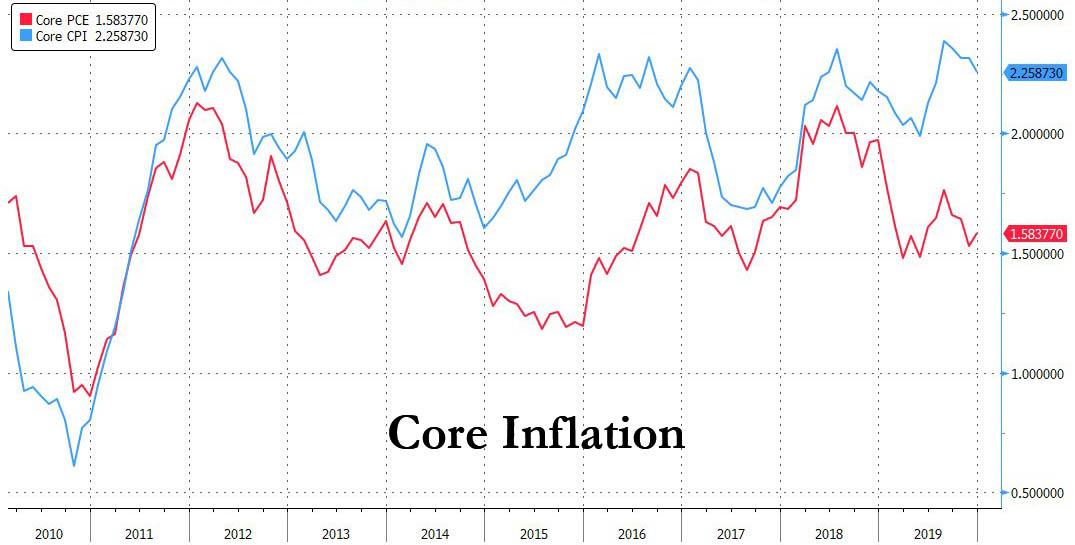Fed’s Price-Targeting Regime: Suggested Changes Fail To Fix The #1 Flaw
Submitted by Joseph Carson, former Chief Economist & Director of Global Economic Research for Alliance Bernstein
Price targeting has failed as a monetary policy experiment, forcing policymakers to now consider a new process to achieve its price stability mandate. Policymakers are considering shifting to an “average” inflation rate over a span of years, rather than trying to hit a specific point target every year. But tinkering with the process is unlikely to achieve better inflation and economic outcomes because it overlooks or ignores the #1 flaw, the price gauge.
Price Targeting
The Federal Reserve adopted a formal 2% price target in 2012, and only once in 2018 have policymakers hit their target. Failure to consistently hit their price target has policymakers scrambling to come up a new way to show their commitment to price stability.
Its been reported that some policymakers are advocating a new policy that would allow reported inflation to run above the 2% target for a few years to counter the years it ran below.
Before changing the process or the time frame it would be advisable to look at all of the factors that could be influencing or distorting the link between monetary policy and reported inflation.
For example, the price index that is targeted might not be providing the accurate price signal policymakers think it is, and different constructions of price indexes can yield different rates of inflation.
Policymaker preferred inflation gauge is the personal consumption expenditure deflator (PCE), not the widely used and traditional consumer price index (CPI). The decision to target the PCE was based on the view it is a “superior” inflation index because it was more comprehensive and more accurate.
The PCE index is more comprehensive, but it is wrong to conclude that it is a “superior” price index for the simple reason it is less of measure of inflation consumers actually experience.
30% of the PCE includes items that are given to the consumer by the government and business. That creates a problem for price measurement because these items are not “sold” to the consumer.
How do you get a price for a good or a service when there is no market transaction? The inclusion of non-market prices has the potential to taint the PCE inflation signal. In 2019, core PCE rose 1.6% whereas core CPI rose 2.3%. Shouldn’t it be of the utmost interest to policymakers to ascertain if the shortfall in PCE inflation relative to the CPI in 2019 was due to imputed prices of items that are not in the CPI?
Also, since 70% of the PCE is based on prices from the CPI any measurement issues or exclusions in the CPI construction would also influence the PCE as well, raising questions over whether the PCE is still the most appropriate index for the price-targeting framework of monetary policy.
For example, the current construction of the CPI no longer captures the price signal from the housing market like it used to.
The Bureau of Labor Statistics (BLS) made the change in its measurement of owner housing because it could no longer ensure a “statistically accurate”measure of housing costs based on the old approach due to an inadequate sample. So BLS now bases its measures of owner housing costs on a rent series, even though it’s a different segment of the housing market.
Yet, the key issue here for policymakers is whether the near-disappearance of the house price signal from the CPI (and out of the PCE as well) still results in a “conceptually correct” measure of inflation that enables members to judge how monetary policy is impacting actual or experience inflation in the economy?
The short answer is no. Not only is owner housing the largest component of both price indexes its also provides the most direct link from changes in interest rates to consumer demand and then to market prices that reflect actual transactions in the real economy.
And no matter if policymakers’ use an “averaging” or “point” estimate process in order to gauge underlying inflation trends it still would not be capturing the most direct and largest price signal that consumers experience or drives inflation expectations.
Only market prices can tell policymakers if the stance of monetary policy is too loose or too tight. Incomplete price measures missed the housing bubble in the 2000s, resulting in monetary policy remaining too easy for too long. Could policymakers be making another mistake nowadays by selecting the PCE over the CPI, thereby setting official rates too low, creating new risks and imbalances?
It remains a puzzle why the most important central bank in the world continues to base its policy decisions on a single price index that includes “artificial” and non-market prices, and excludes the price signal from housing.
No single price index can calculate precisely inflation month-to-month or year-to-year, and biases of a few tenths means of lot with reported inflation low. And while it is silly to think that false precision of a few tenths of a percent on reported PCE inflation could mean the difference between lower of higher official rates policymakers have created the perception its 2% and nothing else.
Averaging the two reported measures of consumer price inflation would make more sense than averaging one measure of inflation over a span of years. The former would at least provide a current reading, even if incomplete, while the later would force policymakers to pick an arbitrary time frame to gauge inflation, perhaps reducing flexibility and creating confusion in the process.
Tyler Durden
Wed, 02/12/2020 – 14:50
via ZeroHedge News https://ift.tt/2SFOEm7 Tyler Durden
